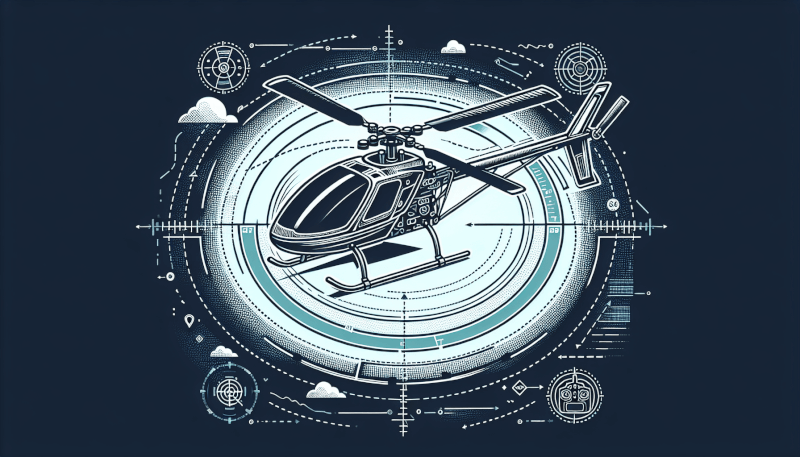Are you new to flying RC helicopters, or perhaps looking for some tips to ensure you stay safe while enjoying this exhilarating hobby? Look no further! In this article, you will find a collection of essential safety tips that will help you navigate the world of RC heli flying with confidence. Whether you are a beginner or a seasoned pilot, these tips are sure to provide you with valuable insights on how to protect yourself, others, and your precious RC heli while experiencing the thrill of flight. So buckle up and get ready to soar through the skies in the safest and most enjoyable way possible!

Pre-flight Preparation
Before taking off with your RC heli, it is crucial to properly prepare yourself and your equipment. Start by reading the instruction manual that came with your RC heli. Familiarize yourself with all the controls and features, and understand the recommended operating procedures.
Next, check your equipment to ensure everything is in good working condition. Inspect the rotor blades, motors, and other components for any signs of wear or damage. Make sure that the battery is securely attached and properly charged. It is essential to have all the necessary tools and spare parts on hand in case of any issues during flight.
Choosing a suitable flying location is also important for a safe and enjoyable experience. Look for an open area with no obstacles, such as trees or buildings, in close proximity. Avoid flying near crowded spaces or areas with heavy pedestrian traffic. Having enough space and minimal distractions will allow you to focus on flying and minimize any risks.
Safety Gear
When operating an RC heli, it is vital to prioritize your safety and protect yourself from any potential hazards. One of the most important safety gear is wearing safety goggles. These goggles will shield your eyes from any flying debris or potential accidents during flight. Always ensure that your goggles fit properly and provide adequate protection.
In addition to safety goggles, it is advisable to wear protective clothing and accessories. This may include long sleeves, pants, and closed-toe shoes to prevent any injuries from the rotor blades. Wearing gloves can also provide additional protection and enhance your grip on the remote controller.
Using a neck strap for the remote controller is another safety precaution worth considering. This strap will secure the controller around your neck, preventing it from accidentally slipping out of your hands during flight. It allows you to maintain full control of the RC heli while also reducing the risk of dropping it and causing damage or injury.
Battery Safety
The battery is a crucial component of your RC heli, and following proper battery safety measures is essential for safe operation. Firstly, always use the correct type of battery recommended by the manufacturer. Using the wrong battery can not only damage your RC heli but also pose a safety risk due to compatibility issues or improper voltage.
Before each flight, inspect the battery to ensure it is in good condition. Check for any signs of swelling, leaking, or damage to the wires and connectors. If you notice any abnormalities, avoid using the battery and replace it with a new one. Remember, compromised or damaged batteries can lead to malfunctions or even fires, so it is always better to err on the side of caution.
When it comes to charging and storing your batteries, it is crucial to follow the manufacturer’s guidelines. Use a reliable and appropriate charger designed for your battery type. Avoid leaving batteries unattended while charging and never overcharge them. Properly storing your batteries in a cool, dry place and away from flammable materials will help prevent any accidents.
Check for Interference
Interference from external sources can disrupt the signals between your remote controller and the RC heli, leading to loss of control or erratic behavior. To minimize interference, it is important to take certain precautions.
Firstly, avoid flying near power lines, electric devices, or areas with high electromagnetic interference. These sources can interfere with the radio frequencies used by your RC heli, potentially causing signal loss or interference.
Additionally, check for nearby Wi-Fi signals, especially if you are flying in a populated area. Wi-Fi networks can also interfere with the radio signals from your remote controller, affecting the control of your RC heli.
It is advisable to test the RC heli’s range before each flight. This will help you identify any potential dead spots or areas where the signal strength might be weak. It is always better to be aware of such limitations and adjust your flying area accordingly to ensure a smooth and safe flight.

Flying Techniques
Mastering flying techniques is crucial to ensure a safe and enjoyable experience when operating an RC heli. Starting with basic maneuvers is essential, especially if you are a beginner. Practice simple movements such as hovering, forward and backward flight, and making gentle turns. This will help you build confidence and familiarize yourself with the controls.
Maintaining a safe altitude is another important aspect of flying an RC heli. Be mindful of your surroundings and avoid flying too high or too close to the ground. Flying too high can lead to loss of orientation, making it difficult to control the heli. On the other hand, flying too close to the ground increases the risk of crashes and damage to both the heli and any potential obstacles.
Always avoid flying over people or animals. RC helis can be unpredictable at times, and a malfunction or loss of control can cause serious harm. By avoiding crowded areas and populated spaces, you reduce the risk of accidents and ensure the safety of those around you.
Weather Conditions
Checking the weather forecast before each flight is essential for a safe and enjoyable experience. Avoid flying in strong winds, as they can not only make it difficult to control the RC heli but also pose a risk of the heli being blown away or crashing.
Flying in rain or snow is generally not recommended unless you have a specifically designed RC heli for such weather conditions. Water can damage the electronics and components of your heli, leading to malfunctions or even permanent damage. It is always better to wait for clear weather conditions to ensure the longevity and proper functioning of your RC heli.

Emergency Procedures
Despite taking all the necessary precautions, unexpected situations can still occur during RC heli flights. Knowing how to perform an emergency landing is crucial in such scenarios. Take the time to learn and practice emergency landing techniques, as they can save your RC heli from further damage and reduce the risk of injury.
If you encounter any unexpected issues during flight, it is important to react calmly. Panic can worsen the situation and lead to poor decision-making. Stay focused, assess the situation, and take appropriate action to minimize any potential risks.
Maintain a safe distance from obstacles during flight, especially when encountering unexpected situations. By keeping a reasonable distance from buildings, trees, or other potential hazards, you give yourself more time to react and maneuver the RC heli safely.
Respect Local Regulations
When flying an RC heli, it is crucial to be aware of and abide by local drone laws and regulations. Different regions and countries may have specific rules regarding the operation of RC helis, including altitude restrictions, no-fly zones, and registration requirements.
Before flying, ensure that you have obtained any necessary permits or licenses that may be required in your area. Familiarize yourself with the specific regulations and guidelines for RC heli operation and adhere to them at all times.
Respect privacy and airspace restrictions when flying your RC heli. Avoid flying over private properties without permission and be mindful of any restrictions regarding areas such as airports, military bases, or sensitive locations.

Maintaining Your RC Heli
Regular maintenance of your RC heli is crucial for reliability and longevity. Make it a habit to regularly check and clean your heli before and after each flight. Remove any dirt, debris, or grass that may have accumulated on the rotor blades or other components.
Inspect and replace any damaged parts promptly. Even minor damage can affect the performance and safety of your RC heli. Regularly check the rotor blades, motors, and other critical components for signs of wear and tear, and replace them as necessary.
Properly storing your RC heli is equally important. Find a cool, dry place where it will be protected from dust and extreme temperature fluctuations. Store it in a case or a dedicated storage compartment to prevent any damage during transportation or while it is not in use.
Fly Responsibly
As RC helis gain popularity, it is essential to fly responsibly and consider the impact on the environment and those around you. Always follow community guidelines and etiquette when flying your RC heli.
Consider the impact of your flight on the environment. Avoid flying in protected areas or disturbing wildlife. Be mindful of noise pollution and fly during appropriate hours to minimize any disruptions to others.
Respect private property and the privacy of individuals. Do not fly over or intrude on private land without permission. It is important to be respectful and considerate of others’ rights and privacy.
By adhering to these safety tips and flying responsibly, you can enjoy the thrill and excitement of operating an RC heli while ensuring the safety of yourself, others, and your surroundings. Happy flying!



